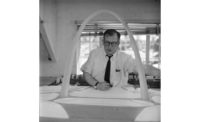Watching the spire of the Notre-Dame Cathedral in Paris collapse, in real time on social media, as a raging inferno engulfed the landmark church on April 15, 2019, was a visceral and emotional experience. The dread of the moment was eventually balanced by hope when it was revealed Notre-Dame’s glorious stained-glass Rose Windows survived. Nevertheless, the World Heritage Site was left in perilous condition.

After firefighters finally smothered the flames, the overwhelming extent of the calamity came into focus. The timber roof was gone, as was its lead cladding. Two limestone roof vaults collapsed and others were damaged when the spire toppled. Lead dust was everywhere. Smoke and water damaged nearly every facet of the cathedral. And looming ominously over the building was a gnarled, melted thicket of scaffolding that threatened to cause further structural harm.
Saving Notre Dame, premiering November 25 on PBS, is a salve for anyone feeling pessimistic about the cathedral’s future. The hour-long documentary serves a kind of companion to the channel's Building Notre Dame, which aired in April, and follows architects, scientists, and engineers as they assess the damage, investigate solutions, and plot how to resurrect the world’s most famous church.

It’s a “logistical nightmare,” a conservator says about removing the toxic dust from Notre-Dame’s windows. But she could easily be describing the work of the dozens of professionals engaged in rebuilding, restoring, and preserving the cathedral. Given age of the building—and the reality that 12th-century craftspeople didn’t leave documentation—the task required teams to go to such lengths as rappelling onto the roof to hand-catalogue and individually remove the charred timber. Rebuilding the vaults necessitates intensive lab investigation to ascertain the type of limestone used, as well as its original source. And every pane of stained glass must be cleaned and inspected for stress fractures caused by the heat of the fire.

That’s just part of the effort, and as eye-crossing as the minutiae may be, it’s also thrillingly cutting edge, offering fascinating details like microscopic views of the roof timber and 800-year-old carpentry marks. Then, there’s the project undertaken by Rémi Fromont, Paris’s chief architect for historic monuments, and Livio De Luca, research director at th eFrench National Centre for Scientific Research. The duo is creating a “digital twin” of Notre-Dame; the data-rich visual model will eventually provide information ranging from the architecture and design of the cathedral to the composition of individual bricks used to build it. The hope is that this will provide a blueprint for the rebuild and restoration.

It’s easy to nerd out on all the high-tech 21st century — and analogue medieval — technology and insight going into the Notre-Dame project. But Saving Notre Dame allows us to do it alongside those conducting the work. Director Joby Lubman takes us into the labs, deep underneath Paris, and, vitally, inside the ravaged cathedral. Unless you’re on the Rapid Response Team, this film is the only way to see, up close, the extent of Notre-Dame’s injuries. We’re so close, in fact, that we scramble out of the building with a team when a sensor monitoring the damaged roof scaffolding sets off an alarm: the tangle of metal has shifted and could collapse. At times, it seems nearly possible to smell the smoke of the mass of roof timber and feel the warmth of the sun pouring through the collapsed roof vaults.
The tactile experience of the film rekindles those pangs of sorrow that came from watching the fire blaze more than a year and a half ago. But witnessing the urgency and care that the assembled team have committed to saving Notre-Dame provides the kind of relief and hope so many of us need right now — that our shared cultural heritage, while fragile, will endure.





Post a comment to this article
Report Abusive Comment